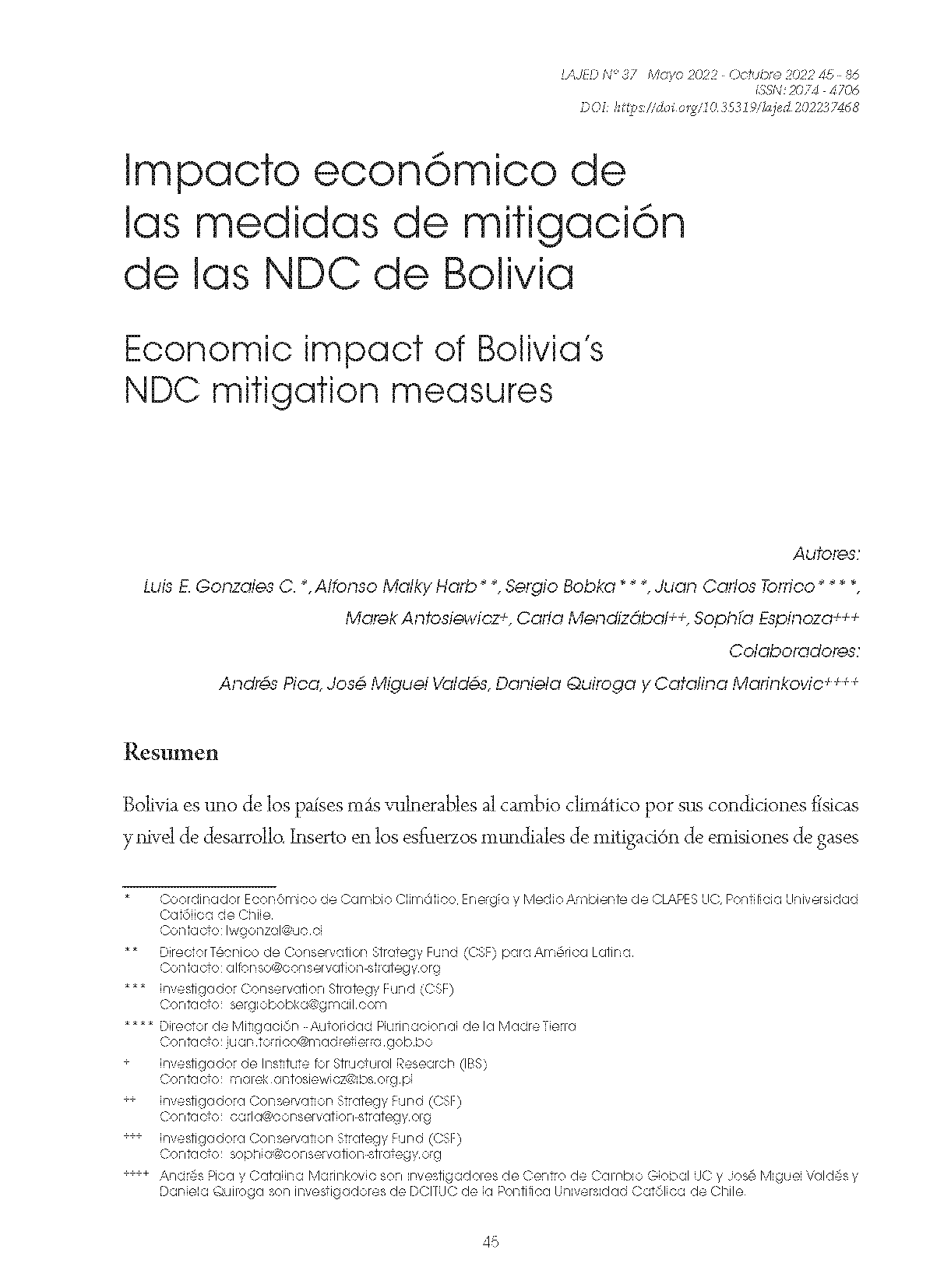Economic impact of Bolivia’s NDC mitigation measures
DOI:
https://doi.org/10.35319/lajed.202237468Keywords:
Climate Change, NDCs, Greenhouse Gas Emissions, Mitigation Measures, Deforestation, Cost-efficiency, GDPAbstract
Bolivia is one of the most vulnerable countries to climate change both because of its physical conditions and development level. Contributing to the global efforts to mitigate greenhouse gas emissions, the country defines measures through their NDCs. This study estimates the economic costs and benefits that these measures generate, and notes that those focused on the forestry and energy sectors could generate a 2.7% annual growth in GDP above the amount projected by 2050. This represents a present value of an additional US$ 15.5 billion as well as net employment generation. The cost of implementing these measures is estimated to represent 30% of the GDP in present values, and their financing would depend on internal and external sources. Finally, it projects that delaying deforestation reduction targets would imply an additional 830 million tons of CO2eq emissions by 2050, with marginal gains in GDP.
Downloads
References
Autoridad de Fiscalización y Control Social de Bosques y Tierra [ABT] (2016). Plan Estratégico Institucional 2016-2020.
Antosiewicz, M., Gonzales, L. E., Lewandowski, P. y de la Maza, N. (2020). Green Growth Opportunities for the Decarbonization Goal for Chile: Report on the Macroeconomic Effects of Implementing Climate Change Mitigation Policies in Chile 2020. World Bank. https://openknowledge.worldbank.org/handle/10986/34575
Antosiewicz, M. y Gonzales, L. (2021) Macroeconomic model for the assessment of mitigation policies in Bolivia, Mimeo.
Antosiewicz, M. y Kowal, P. (2016). MEMO III - A large scale multi-sector DSGE model. (IBS Research Report 02/2016). http://ibs.org.pl/en/publications/memo-iii-a-largescale-dsge-model/
Anwar, A. (2001). Does the Age of a Tree Effect Carbon Storage. NASA. https://icp.giss.nasa.gov/research/ppa/2001/anwar/
Asociación Nacional Automotriz de Chile (2019). Informe del mercado automotor. ANAC.
Autoridad Plurinacional de la Madre Tierra (2020). Tercera Comunicación Nacional del Estado Plurinacional de Bolivia. Gobierno Nacional de Bolivia.
Cámara Forestal de Bolivia (2021, 17 de junio). Perspectivas de la actividad forestal en Bolivia. https://www.cfb.org.bo/noticias/noticias/normativa/perspectivas-de-laactividad-forestal-en-bolivia.html
Climate Watch (2021). Greenhouse Gas Emissions and Emissions Targets. https://www.climatewatchdata.org/countries/BOL?end_year=2018&start_year=1990
Espinoza, S., Malky, A. y Bruner, A. (2015). Análisis de costos del Programa COMSERBOPando Bolivia. (CSF Serie Técnica N° 43).
Fundación Amigos de la Naturaleza [FAN] (2019). Incendios forestales en Bolivia 2019-2020. https://incendios.fan-bo.org/Satrifo/incendios-forestales-en-bolivia-2019-2020/
Fundación Amigos de la Naturaleza [FAN] y Wildlife Conservation Society [WCS]. (2021). Incendios forestales en Bolivia. Análisis de impactos de los incendios forestales sobre los valores de conservación en Bolivia, 2020. Fundación Amigos de la Naturaleza. FAOSTAT. https://www.fao.org/faostat/es/
Gobierno del Estado Plurinacional de Bolivia (2020). Plan de recuperación de zonas afectadas por incendios en el departamento de Santa Cruz. Gobernación de Santa Cruz.
Gobierno del Estado Plurinacional de Bolivia (2018). Deforestación en el Estado Plurinacional de Bolivia. Periodo 2016-2017. Autoridad de Fiscalización y Control Social de Bosques y Tierra.
Global Forest Watch (2021). Pérdida de cobertura arbórea 2001-2020. https://www.globalforestwatch.org/map/?map=eyJjZW50ZXIiOnsibGF0IjotNC45NTI4NTAwMzc4ODc1MTIsImxuZyI6LTcwLjc5Mjk2ODc1MDAwMTY4fX0%3D
IPCC (2022). Climate Change 2022: Mitigation of Climate Change. Contribution of Working Group III to the Sixth Assessment Report of the Intergovernmental Panel on Climate Change. Cambridge University Press. https://doi.org/10.1017/978100915792
Malky, A., Ledezma, J.C., Vilela, T. y Mendizábal, C. (2021). Contribución de las áreas protegidas nacionales de Bolivia en la provisión de funciones ambientales: descripción metodológica y materiales complementarios. Conservation Strategy Fund.
Ministerio de Hidrocarburos y Energías [MHE]. (2020). Plan para el desarrollo de energías alternativas en Bolivia. Ministerio de Hidrocarburos y Energías. National Renewable Energy Laboratory. https://www.nrel.gov/research/data-tools.html
Ortuño, A. (2016). Estudio técnico, económico y social del sistema de alumbrado público con tecnología LED en la ciudad de La Paz. Universidad Mayor de San Andrés (UMSA).
Sanquetta, C., Dalla, A., Libanio, A., Tomé, M., Benedet, G. e Inoue, M. (2018). Dynamics of carbon and CO2 removals by Brazilian forest plantations during 1990-2016. Carbon Balance Management, 13. https://doi.org/10.1186/s13021-018-0106-4
Pellegrini, A. F. A., Refsland, T., Averill, C., … y Jackson, R.B. (2021). Decadal changes in fire frequencies shift tree communities and functional traits. Nature Ecology & Evolution, 5, 504–512. https://doi.org/10.1038/s41559-021-01401-7
Ter Steege, H., Pitman, N., Sabatier, D., Baraloto, C., … & Silman, M.R. (2013). Hyperdominance in the Amazonian Tree Flora. Science, 342(6156). https://doi.org/10.1126/science.1243092
Viceministerio de Electricidad y Energías Alternativas (2014). Plan eléctrico del Estado Plurinacional de Bolivia 2025. Ministerio de Hidrocarburos y Energía.
World Resources Institute (2014). Global Protocol for Community-Scale Greenhouse Gas Emission Inventories. World Resources Institute.

Downloads
Published
How to Cite
Issue
Section
License
Copyright (c) 2022 Latin American Journal of Economic Development

This work is licensed under a Creative Commons Attribution-NonCommercial 4.0 International License.





